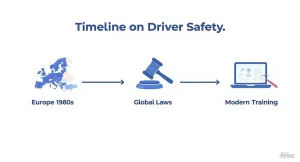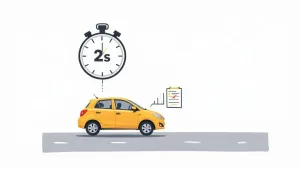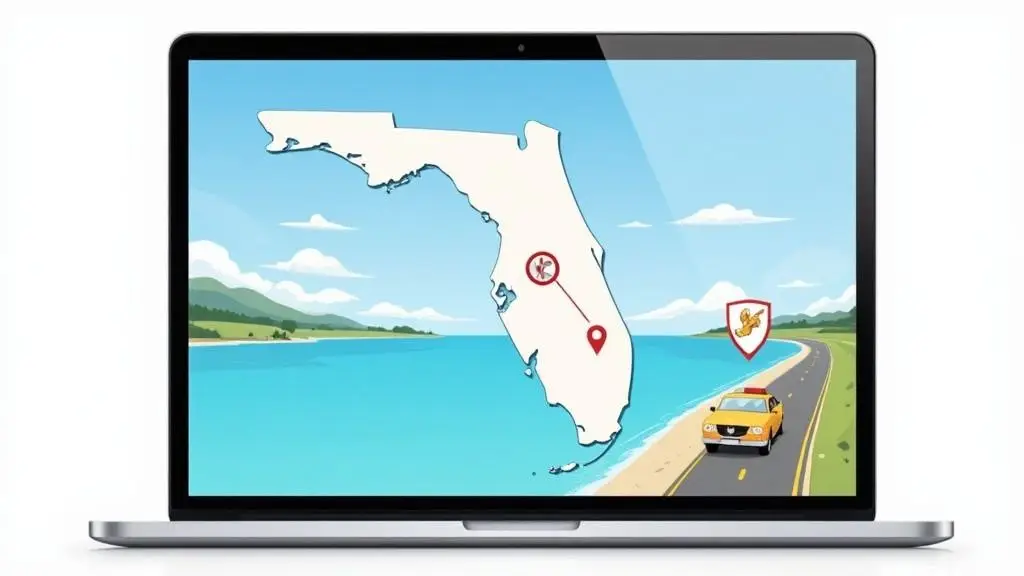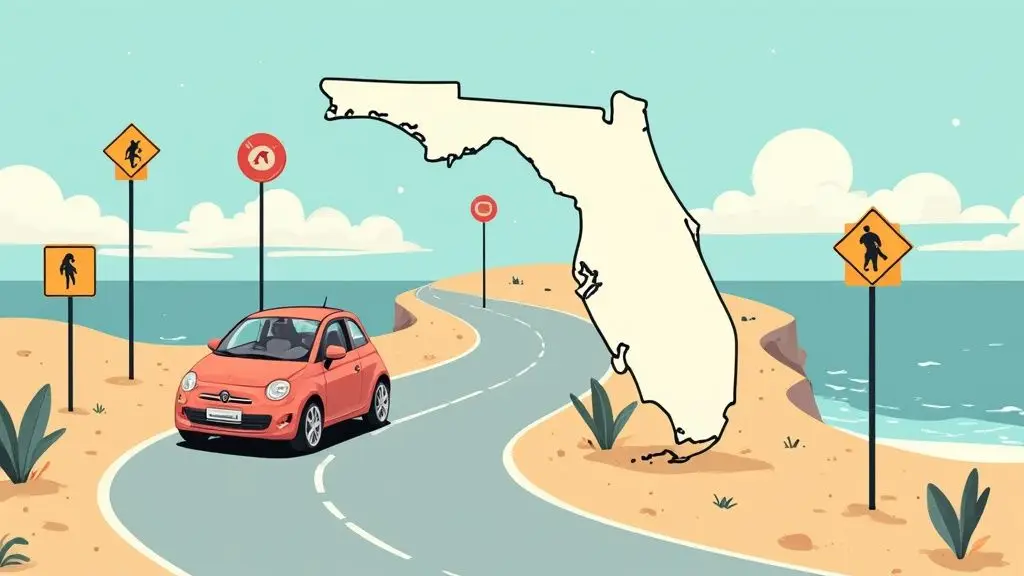A point reduction course is a state-approved defensive driving program that lets you knock points off your official driving record. It’s a smart, proactive move after a minor traffic ticket—one that helps you keep your record clean and your insurance rates from climbing. Taking the course shows you’re serious about driving safely.
What a Point Reduction Course Does for Your Record

Think of your driver’s license as having an invisible scoreboard. Every time you get a ticket for a moving violation, like speeding or blowing past a stop sign, the state adds points. This isn’t just for show; it’s how the Department of Motor Vehicles (DMV) keeps tabs on drivers who might be a risk on the road.
A point reduction course basically works like a reset button. When you finish a state-certified course, a set number of those points get wiped from your record. It’s a much better alternative than just paying the ticket and accepting the consequences, which almost always include some financial pain.
The Problem With License Points
Letting points pile up on your license triggers a whole chain of negative effects that last much longer than the sting of the initial fine. To the state and your insurance company, each point is a red flag that screams “higher risk.” This can cause some serious headaches down the line.
Here’s what you’re up against when points start adding up:
- Skyrocketing Insurance Premiums: Insurance companies see points as a sign you’re more likely to get into an accident and file a claim. To them, it’s simple math—they’re going to raise your rates. Just one ticket can jack up your premiums by 20-25%, sometimes even more.
- Risk of License Suspension: Every state has a limit. In Florida, for example, getting 12 points within a 12-month period means an automatic license suspension. No questions asked.
- Long-Term Financial Impact: When you combine higher insurance costs with potential fines and reinstatement fees, you could be looking at thousands of dollars in extra costs over just a few years.
How the Course Provides a Solution
This is where a point reduction course comes in and saves the day. Instead of just letting those points sit there and damage your record, you spend a few hours refreshing your memory on traffic laws and learning smart defensive driving skills. The whole point is to make you a safer, more alert driver.
By completing a course, you’re not just clearing points; you are actively demonstrating to the state and insurance companies that you are a responsible driver committed to road safety. This proactive step can prevent years of financial strain.
It’s a simple trade-off, really. You give a little bit of your time to education, and the state agrees to scrub those pesky points from your license. The whole system is strictly regulated, so you absolutely have to use an approved provider to make sure it counts.
If you want to dig a little deeper into how these programs work, you can learn more about what traffic school is and see how it helps drivers handle citations. It’s a powerful tool for protecting your driving privileges and keeping your insurance costs from getting out of control.
Where Did Driver Safety Courses Come From, Anyway?
It’s easy to think of a point reduction course as just another piece of the traffic law puzzle, but these programs are actually a pretty modern invention. They didn’t just pop up overnight. Their story begins with a major shift in thinking about road safety—a move away from simply punishing bad drivers to actively educating them. And believe it or not, this whole idea started across the Atlantic.
Back in the 1980s, European countries were grappling with a surge in traffic, which naturally led to more accidents. Officials, especially in places like Germany, started to realize that handing out tickets wasn’t enough to make the roads safer. This sparked the first real defensive driving programs, designed to teach better driving habits instead of just penalizing mistakes.
A New Philosophy: From Punishment to Prevention
The concept was a game-changer. Instead of just hitting drivers with fines and points after they did something wrong, why not give them a reason to actively improve their skills? This change in strategy is the foundation of the safety courses we have today. The aim was to create a culture where learning to be a better driver is an ongoing process, not a one-and-done deal when you get your license.
And it worked. The new educational model was a huge success. It turned out that when drivers understood the why behind the rules—like the physics of how long it takes to stop or the real dangers of glancing at a phone—they were far less likely to make the same mistakes again. The logic was simple but powerful: a smarter driver is a safer driver.
This philosophy is still a huge part of driving culture in Europe. In countries like Germany and France, over 80% of drivers take some kind of refresher or defensive driving course every five years, often encouraged by government programs and public awareness campaigns. You can find more data on European driving training services at Archive Market Research.
Coming to America and Going Digital
The success in Europe didn’t stay a secret for long. Lawmakers around the world, including here in the United States, started to adopt the model, creating the point reduction course system we’re familiar with. At first, though, these were clunky, in-person classes. You’d have to sacrifice a weekend to sit in a stuffy classroom, which was a major headache for anyone with a job or a family.
Then came the internet, and everything changed. Moving these courses online made driver safety education available to practically anyone.
The switch to online courses opened the doors for everyone. All of a sudden, you could complete the training on your own time, from your own home, without worrying about your schedule or how you’d get there.
This digital shift made the whole experience better in a few key ways:
- Total Flexibility: Drivers could now chip away at the course whenever they had free time, fitting it in around their lives instead of the other way around.
- More Engaging Content: Forget boring lectures. Online courses use videos, interactive quizzes, and animations to make the material stick.
- Instant Results: As soon as you finish, you can often download your certificate and send it right over to the court or DMV. No more waiting.
Today’s online traffic schools are the direct descendants of that journey. Knowing this history helps you see a point reduction course for what it really is: not just a way to deal with a ticket, but a genuinely effective tool for making our roads safer for everyone.
A Step-by-Step Guide to Your Point Reduction Course
So, you’ve decided to take a point reduction course. Good move. It might seem like a lot to handle on top of a traffic ticket, but the process is actually pretty logical. Let’s break it down into a simple, step-by-step plan to get you from the citation to a cleaner driving record.
This timeline shows just how far driver safety education has come, evolving from a simple penalty to a powerful tool for creating safer drivers.

As you can see, the focus has shifted over the years toward making these courses more accessible and proactive, helping everyone on the road.
Step 1: First Things First, Are You Eligible?
Before you even think about enrolling, you need to make sure you actually qualify. This is the most important first step. Not every ticket is eligible for a point reduction course. States generally reserve this option for minor moving violations—think speeding a little over the limit or a rolling stop.
More serious offenses like a DUI, reckless driving, or causing a serious crash are almost always off the table. There are also limits on how often you can use this get-out-of-jail-free card. Many states only allow you to take a course for point reduction once every 12 to 24 months. The only way to know for sure is to check with the court that issued your ticket or your state’s DMV.
Step 2: Find a Course the State Approves Of
Okay, you’re eligible. Now you need to find a course provider that’s officially approved by your state. This part is non-negotiable. If you take a course from a provider that isn’t on the state’s certified list, you’ve just wasted your time and money. The court won’t accept it, and those points aren’t going anywhere.
Choosing a state-approved provider is the only way to guarantee the court will accept your completion certificate and reduce your points. Always verify the school’s status on your official DMV or court website before paying for anything.
You’ll usually find two main types of courses to choose from:
- Online Courses: These give you the ultimate flexibility. You can chip away at the material whenever you have free time, from your home or office. For most people with busy lives, a reputable online driving school is the way to go.
- In-Person Classes: If you’re someone who learns better in a traditional classroom with a real, live instructor, this might be your best bet. The direct interaction and ability to ask questions on the spot can be really helpful.
Step 3: Buckle Down and Complete the Course
Once you’re signed up, it’s time to get to work. The course itself will walk you through essential defensive driving skills, refresh your memory on traffic laws (which may have changed since you got your license), and teach you how to spot and avoid common road hazards. The material is typically divided into easy-to-digest chapters or modules.
Most courses will have you take a short quiz after each section to make sure you’re retaining the information. You’ll have to pass these little quizzes to unlock the next part of the course. At the very end, there’s a final exam. Pass that, and you’re golden.
Step 4: Submit Your Certificate and Double-Check Your Record
Getting that certificate of completion feels great, but you’re not quite at the finish line. The final step is all on you. You must submit that certificate to the right place—which is usually the court that handled your ticket or the DMV—before your deadline.
Don’t just send it in and forget about it. A few weeks later, do yourself a favor and pull a copy of your official driving record. Make sure the points were actually removed. This one last check ensures all your hard work paid off and gives you the peace of mind that your record is clean.
How to Meet Florida’s Point Reduction Requirements
Trying to figure out traffic laws can sometimes feel a bit overwhelming, but when it comes to a point reduction course in Florida, the rules are actually pretty straightforward. The Sunshine State, through the Florida Highway Safety and Motor Vehicles (FLHSMV), has a clear-cut system that gives drivers a chance to fix their record after a minor traffic mishap.
Knowing these guidelines is the secret to getting those points removed and keeping your driving privileges safe.
The main way to do this is by taking a Basic Driver Improvement (BDI) course. You can think of this as the official Florida name for a point reduction course. It’s a state-approved program that does more than just get a ticket dismissed—it’s designed to sharpen your defensive driving skills, which helps make the roads safer for all of us.
Who Can Take a BDI Course in Florida?
Not every traffic ticket opens the door to taking a BDI course. Florida reserves this option for drivers who’ve committed a non-criminal moving violation. This means more serious offenses, like a DUI or reckless driving, don’t qualify. The idea is to give a second chance to someone who made a common mistake, not to excuse dangerous driving.
Here are the key requirements set by the FLHSMV:
- You must officially choose to take the course within 30 days of getting your citation. This is a hard deadline, so don’t wait!
- Your ticket must be for a non-criminal moving violation. Think things like speeding, rolling through a stop sign, or making an improper lane change.
- You cannot have a Commercial Driver’s License (CDL), even if you were driving your personal car when you got the ticket.
Florida also puts a cap on how often you can use this option. You’re allowed to take a BDI course to reduce points only once every 12 months and no more than five times in your entire life.
The Official Steps to Get Your Points Reduced
So you’ve confirmed you’re eligible—great! The process from here is simple. Just follow these steps carefully to make sure the court and the FLHSMV credit you for your work.
- Tell the Clerk of Court: Within 30 days of your citation, you have to let the Clerk of Court in the county where you got the ticket know that you plan to take a BDI course. You’ll also need to pay the court fees at this time.
- Sign Up with a State-Approved School: This is a big one. You have to pick a course provider that’s officially certified by the FLHSMV. If the school isn’t on their list, your completion certificate won’t count. You can easily find an approved traffic school online to be sure you’re choosing a legitimate program that meets all the state’s rules.
- Finish the Course: The Florida BDI course is at least four hours long. The beauty of online courses is that you can tackle these hours whenever it fits your schedule.
- Turn in Your Certificate: Once you pass, you’ll get a certificate of completion. It’s up to you to get this proof to the correct Clerk of Court before their deadline.
Completing a Florida-approved BDI course does more than just keep points off your license for that ticket. It also stops your insurance company from jacking up your rates because of it, which can save you a ton of money down the road.
To help you decide which course format is best for you, here’s a quick comparison of your options.
Florida Point Reduction Course Options at a Glance
| Provider Type | Typical Duration | Average Cost | Points Reduced |
|---|---|---|---|
| Online BDI Course | 4 Hours (self-paced) | $25 – $40 | 3-4 (per violation) |
| In-Person BDI Course | 4 Hours (classroom) | $40 – $60 | 3-4 (per violation) |
Whether you prefer the convenience of learning from home or the structure of a classroom, both paths lead to the same result: a cleaner driving record.
Double-Check That Your Record Is Clean
After you’ve submitted your certificate, don’t just cross your fingers and hope for the best. It’s always a good idea to follow up. A few weeks later, you can check your driving record on the FLHSMV website to make sure no points were actually added for that violation.
The FLHSMV offers a lot of resources for driver education, which really shows the state’s focus on safety. By following Florida’s clear-cut process, you can confidently use a point reduction course to keep your driving record in great shape.
So, What Are the Real Payoffs of Taking This Course?
Sure, finishing a point reduction course helps clean up your driving record, and that’s a great start. But the true value goes way beyond that single benefit. Think of it as a small investment in your driving future that pays you back in both immediate savings and long-term confidence.
The most obvious win is avoiding a nasty jump in your car insurance rates. After a ticket, your insurer often flags you as a higher risk, which is their cue to raise your premiums. By completing a state-approved course, you’re showing them you’re taking the violation seriously and actively working to be a safer driver.
This single proactive step can be enough to convince them not to hike your rates, potentially saving you hundreds or even thousands of dollars over the next few years. When you compare the small, one-time cost of the course to years of inflated insurance bills, the choice is pretty clear.
It’s About Becoming a Smarter, Safer Driver
Financial perks are great, but a point reduction course is really designed to sharpen your skills behind the wheel. This isn’t just about passing a test; it’s about relearning the core principles of defensive driving that can help you steer clear of future accidents and tickets.
You’ll get a solid refresher on a lot of the critical stuff that might have gotten a bit fuzzy since you first earned your license. The best courses dive deep into practical skills like:
- Hazard Identification: Training your eyes to spot potential problems on the road long before they become emergencies.
- The Two-Second Rule: Truly mastering safe following distances so you always have enough time to react.
- Managing Distractions: Getting a real-world understanding of the dangers of distracted driving and building habits to maintain focus.
- Adapting to Conditions: Learning how to confidently handle everything from slick roads in a downpour to unpredictable rush-hour traffic.
And this isn’t just theory—it works. Studies consistently show that drivers who complete defensive driving courses have a 10% to 15% lower risk of being in another crash or getting a ticket in the following two years. You can dig into more of the data on defensive driving training technology and its market impact if you’re curious.
The Financial Benefits Don’t Stop There
The savings from a point reduction course often extend far beyond just sidestepping that initial insurance increase. When you become a safer, more aware driver, you naturally reduce your chances of getting another ticket. That means fewer fines, no court costs, and no need to miss work for a hearing.
On top of that, many insurance companies offer a direct discount for voluntarily taking a defensive driving course. This is a separate perk from just avoiding a rate hike after a ticket.
It’s a pretty simple calculation for insurers: educated drivers are safer drivers, and safer drivers file fewer claims. That makes you a much more attractive customer.
Typical Insurance Discounts After Course Completion
To give you a clearer picture, here’s a look at what kind of discounts you might see in a few different states after completing a course. Keep in mind that these are averages, and your actual savings will depend on your specific insurer and driving history.
| State | Points Reduced | Average Discount |
|---|---|---|
| Florida | 3-4 points | 5-10% |
| New York | Up to 4 points | 10% |
| Texas | N/A (Dismissal) | 5-10% |
| California | N/A (Masking) | 5-15% |
As you can see, the financial incentive is real. Whether it’s through point reduction or ticket dismissal, the end result is often a welcome drop in your premium.
Think of the course as a two-for-one deal. It solves your immediate problem—the points and potential rate hike—while also opening the door to future discounts and long-term savings.
If you want to understand the mechanics behind this, our guide on how a defensive driving class can lower insurance breaks it all down. It’s a classic win-win for both you and your insurance provider.
The Best Benefit? Peace of Mind.
At the end of the day, one of the most valuable takeaways isn’t something you can track on a spreadsheet. It’s the genuine peace of mind you get from knowing your driving record is in good shape and you have the skills to handle whatever the road throws at you.
Instead of stressing about how many points you have or worrying about a potential license suspension, you can get back to driving with confidence. You’ll feel more in control, more aware of what’s happening around you, and better equipped to keep yourself and your passengers safe.
That feeling of confidence is a powerful reward. Completing a point reduction course isn’t just about satisfying a court requirement; it’s a meaningful step toward becoming a more skilled and responsible driver for life.
Succeeding In Your Defensive Driving Course

You’ve made a wise move by enrolling in a point reduction course, but the real goal is to come away a safer, more skilled driver—not just to earn a certificate. With a few smart habits and a positive mindset, this experience can reshape how you handle everyday traffic challenges.
Think of this as more than a requirement; it’s an opportunity to adjust your driving habits. As you progress, these strategies will help you absorb the material faster and feel confident on the road.
Creating Your Ideal Study Environment
First things first: where you study sets the tone.
Set up a quiet space that’s free from family chatter, pet distractions, and endless phone notifications. Next, block out specific time slots in your calendar and let others know those moments are off-limits.
Active Learning Techniques That Work
Clicking “next” isn’t enough. You want to interact with the content so the lessons stick.
- Take Deliberate Notes: Jot down ideas like the two-second rule for following distances in your own words rather than copying text verbatim.
- Pause and Visualize: When a scenario pops up—say, merging onto a highway—pause, imagine yourself at the wheel, and mentally rehearse the steps.
- Explain It Out Loud: Teaching a concept to a friend (or even talking to yourself) forces you to clarify and reinforce your understanding.
Treat this course as a chance to upgrade your on-road skills rather than just checking a box. That shift in perspective can make all the difference.
Applying Your New Skills Immediately
The moment you log off, you step into your real-world classroom: the streets.
Next time you drive, use the habits you’ve practiced. Actively scan for hazards, keep that two-second cushion, and double-check blind spots. Each time you apply a lesson, it cements safer behavior and chips away at those points on your record.
Frequently Asked Questions
Even after mapping out the process, a few practical questions usually pop up. Let’s tackle some of the most common ones that drivers ask about point reduction courses so you can move forward with confidence.
How Quickly Are Points Removed After I Finish The Course?
This really depends on your state and the specific court handling your ticket. After you hand in your completion certificate, the gears of bureaucracy start turning. It could take just a few days, or it might stretch out for several weeks before your record is officially updated.
A good rule of thumb is to check in with your state’s DMV a few weeks after you submit the certificate. A quick call or online check can confirm the points have actually been removed.
Can I Take A Point Reduction Course For Any Traffic Ticket?
Unfortunately, no. These courses are generally designed for minor, non-criminal moving violations. Think things like a garden-variety speeding ticket, rolling through a stop sign, or making an improper lane change.
Serious offenses are a different story and typically won’t qualify you for point reduction through a standard course. These include violations like:
- Driving Under the Influence (DUI)
- Reckless driving citations
- Any ticket stemming from a serious accident
How Often Can I Take A Course To Reduce Points?
States put a limit on how often you can use a defensive driving course to wipe away points. A common restriction is once every 12 to 24 months.
It’s crucial to check your local DMV’s rules before you sign up. If you take a course too soon after a previous one, you might find you’re not eligible for point removal on your latest ticket.
One thing to remember: your insurance company won’t automatically know you’ve completed the course. It’s up to you to send them the certificate and ask about potential discounts. A little proactivity here can lead to some nice savings.
Ready to clear your record with a flexible, state-approved course? BDISchool offers a fully online Basic Driver Improvement Course that meets all Florida requirements. Get started today at https://bdischool.com.





